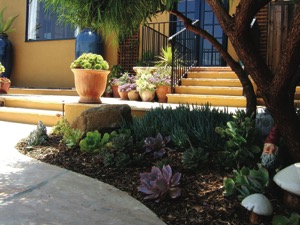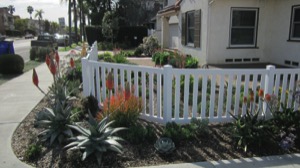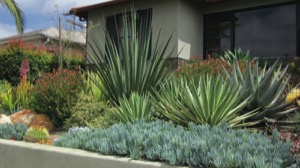
It’s no secret that San Diego and the rest of California are in the midst of a drought. Turn on the television or read the newspaper and you will see a reminder of the worsening drought conditions on a regular basis.
For the fourth consecutive year, California has experienced lower than average rainfall and the snowpack in the Sierra Nevada is also below average, making the already troublesome drought conditions more precarious.
Many water saving regulations are already in place, including only watering your lawns on certain days and only during specific hours. Due to the drought, many San Diego homeowners have already made the switch from traditional gardening to xeriscaping in an effort to limit water usage.
So San Diego LGBT Weekly took to the The Greater San Diego Business Association (GSDBA) Directory and asked two professional landscapers, Joel Berlin of AnandaScapes and Randy Laurie of Laurie’s Landscaping, to share their tips on transitioning from standard landscaping to xeriscaping.
What is xeriscaping?
Xeriscaping, which is a form of landscaping that uses plants that require minimal water, has rapidly gained in popularity over the past few years. Berlin noted that the popularity of xeriscaping at AnandaScapes has doubled in the last year.
“With the drought conditions in Southern California continuing, more and more xeriscaping is being done not only on single family homes, but also on condominiums, apartment buildings, commercial properties and even in our parks and roadsides,” confirmed Laurie.
Xeriscaping uses native plants that require little to no water. To add variety to the Southern California plants, nurseries import plants from Australia, which has a similar ecosystem.

The benefits of xeriscaping
There are many ecological and aesthetic benefits to xeriscaping.
“The main benefit of xeriscaping is to conserve water by reducing the irrigation needs of the landscaping,” said Laurie. “Grass lawns are usually the largest water guzzlers.”
Although some people may have trouble imagining their homes without a grassy lawn, xeriscaping can produce equally beautiful outdoor areas. You can even put in synthetic turf if you need the green look of grass.
Other xeriscaping options include combinations of drought-tolerant plants, gravel, flagstone, mulches and small boulders. By using low-water landscaping, homeowners can save up to two-thirds the amount of water that traditional gardening requires.
“Xeriscaping does not mean a cactus garden,” emphasized Berlin. “It means using California native plants that are naturally geared for low water ecological systems. These systems include the Coastal Sage, the Chaparral, the Inland Foothills, the Low Desert and the High Desert.”
Another benefit to creating a xeriscaped garden is less maintenance. Unlike traditional gardens and lawns that require weekly or biweekly upkeep, most xeriscaping requires minimal touch-ups every two to three months. This makes it ideal for people who weren’t born with a green thumb or who don’t have time to maintain landscaping.
“It will help if you pick plants that will grow to the proper size for the space and placement and if you stay away from some grasses and plants that need to be cut back at certain times of the year,” said Laurie. “Rocks and gravel can add a lot to the overall look and require no maintenance.”

The drawbacks to xeriscaping (and how to get around them)
As with almost anything, there are a few drawbacks to xeriscaping but there are also ways to turn the negatives into positives.
The upfront cost of redesigning landscaping can be a deterrent for some homeowners. However, the overall costs saved on yearly maintenance on a xeriscaped yard can help to justify the initial price tag.
Some critics also dislike thorny plants, such as cacti or agave, and fear that they could harm children or animals. However, there are plenty of drought-tolerant plant alternatives that do not have thorns and gardeners can plan their landscaping according to their family’s needs.
There’s also a learning curve with some of the plants, especially since they aren’t as widely known with traditional gardeners. Learning when and how to trim the plants to keep them from growing out of control is crucial, as is understanding that some of the plants go dormant during certain times of the year.
“But we are developing new varieties that are more compact and hardy with longer blooming periods and variety in color,” said Berlin. “These tamer varieties are becoming more suited for the common residential garden.”
How to get started with xeriscaping
If you’re ready to take the plunge and give xeriscaping a try, here are some suggestions on how to get started.

First, you can select a small area of your yard to begin xeriscaping and test the waters. Laurie recommends the strip between the sidewalk and the street or a plant bed or two. Ask for suggestions of water-conserving plants, such as shrubs and succulents, from your local plant nursery or get a consultation from a landscape designer.
“Play with how (the plants) go together. Take a small area and give it a try,” said Berlin. “If your plants are flourishing after one year, then expand on your concept.”
Another easy way to get started and make a big difference on water usage is to install a synthetic turf lawn.
“Most people are quite surprised to see how real a good synthetic turf looks and feels now,” said Laurie.
It’s always a good idea to do your research before starting a major project, like xeriscaping. Find examples of yards that you like in your community or search books, magazines and the Internet for more design ideas.
“A well planned xeriscaped yard not only saves water but brings in wildlife, such as hummingbirds and butterflies,” said Berlin.
More information on conserving water
Nov. 1, 2014, the City of San Diego enacted the Drought Alert mandatory water use restrictions. The current restrictions state that odd-number addresses water only on Sundays, Tuesdays and Thursdays; even-number addresses water only on Saturdays, Mondays and Wednesdays and apartments, condos and businesses water only on Mondays, Wednesdays and Fridays.

From Nov. 1-May 31, watering with a standard sprinkling system must take place between 4 p.m. and 10 a.m. for only seven minutes. From June 1-Oct. 31, it must be between 6 p.m. and 10 a.m.
Other restrictions include shutting off ornamental fountains and only washing cars during the above mentioned hours. Check the Web site below for updates on water restrictions.
City of San Diego Waste No Water
Information and Resources:
sandiego.gov/water/conservation/drought/prohibitions.shtml
ANANDASCAPES
3813 Ray St.
San Diego, CA 92104

(619) 701-9875
LAURIE’S LANDSCAPING
3942 Boundary St.
San Diego, CA 92104
619-251-6455












If it isn’t already, all new real estate developments (housing, shopping, office parks, etc.) in California should be required to do xeriscaping. Lose the lawns!